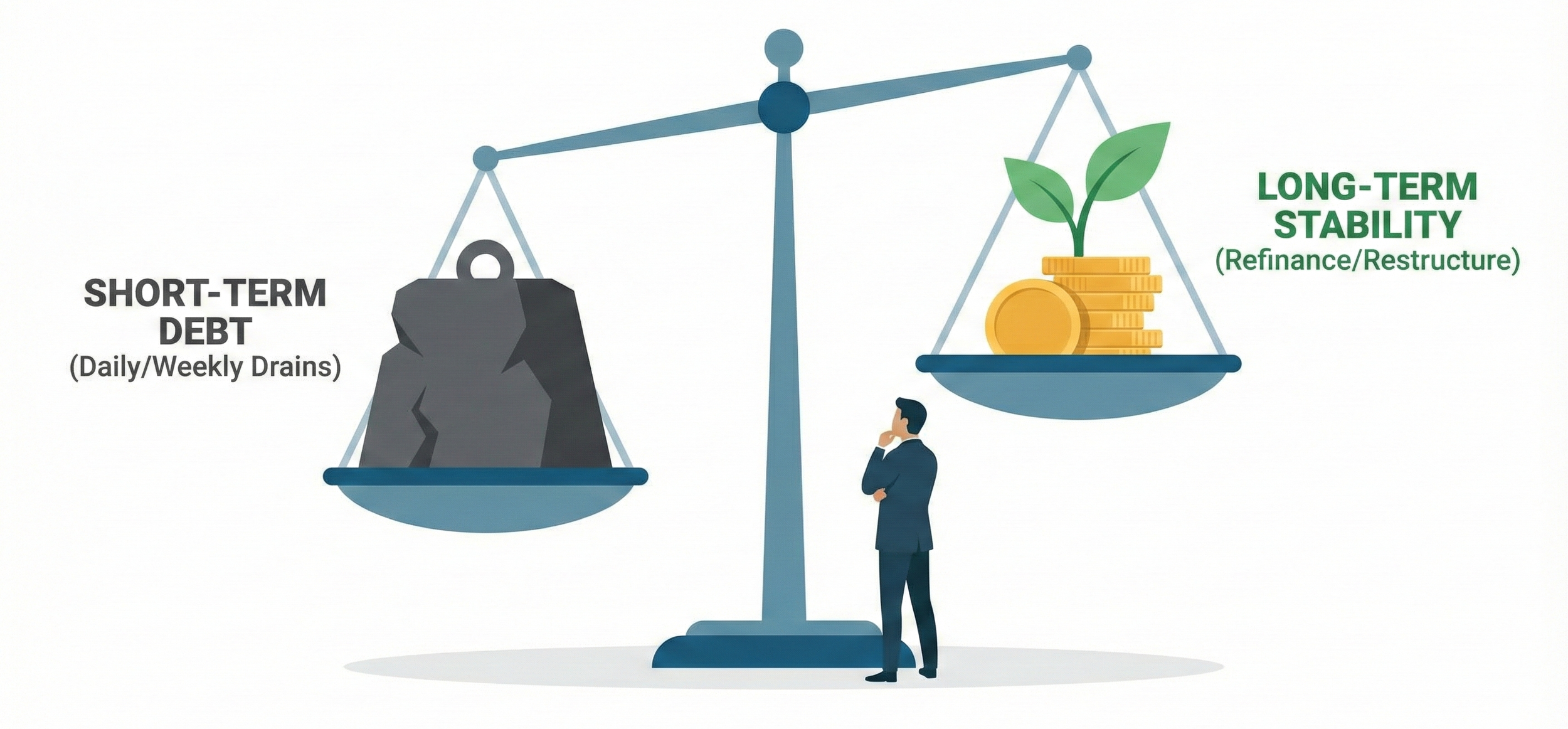The Private Credit and Growth Capital Marketplace for Small and Medium-sized Businesses
For the ambitious small or medium-sized business owner, there comes a point where growth feels both tantalizingly close and frustratingly out of reach.
You have the orders, the strategy, and the team, but the capital required to seize the opportunity exceeds the rigid parameters of traditional bank lending.
This is the moment many entrepreneurs discover the world of private credit and growth capital—a sophisticated, dynamic, and demanding marketplace that can provide the fuel for transformational growth, but only for those who are meticulously prepared.
This article will pull back the curtain on this exclusive world, revealing what these capital providers look for, what they demand in return, and how you can position your company to successfully secure the funding you need to reach the next level.
Beyond the Bank:
An Introduction to the Private Credit Universe
When your local or national bank says "NO" it’s not necessarily a judgment on your business's potential.
More often, it's a reflection of their regulatory constraints and conservative risk models.
Banks are typically focused on asset-backed lending and historical cash flows, making them hesitant to finance bold growth plans, complex situations like management buyouts, or strategic acquisitions.
This is the gap that the private credit market was born to fill.
Private credit funds are pools of capital raised from institutional investors—like pension funds, endowments, and insurance companies—specifically to be lent directly to private companies.
They are not banks; they are investment funds seeking a return.
They provide everything from senior secured term loans to mezzanine debt and uni-tranche facilities, often in amounts ranging from $2 million to over $100 million.
This capital isn't just a loan; it's a strategic partnership designed to fund significant value-creating events.
But this partnership comes with a different set of rules, expectations, and a level of scrutiny far beyond what most business owners have ever experienced.
Understanding this dynamic is the first step toward navigating it successfully.
The Investor's Calculus:
Understanding the Lender's Mindset
To successfully raise capital in the private credit market, you must first stop thinking like a borrower and start thinking like an investor.
A private credit fund isn't just lending you money; they are buying a piece of your company's future cash flow.
Their primary mandate is to preserve their investors' capital and generate a return that justifies the immense risk they are taking.
Consider a common scenario: a fund is asked to provide a $2 million loan to your company
A portion of this loan will be used to pay off high-cost and short-term payback debt like a merchant cash advance, short-term business loan or a factoring facility, which may be consuming your profits (from high interest) and cash flow (from short amortizations).
The remainder is for working capital to fund a large new contract.
From the lender’s perspective, this is a high-risk proposition.
They are betting that your company, once freed from its expensive debt and armed with fresh capital, can execute its plan flawlessly and generate enough profit to cover their loan payments, even if the economy softens or a key customer is lost.
To mitigate this risk, they operate with what can only be described as "sharp elbows."
Their terms are their terms.
The mentality is often "take it or leave it," because they have a fiduciary duty to their own investors to structure the most de-risked deal possible.
They are not there to be your friend; they are there to be your financial partner under a very specific and legally binding set of conditions.
Are You a Fit?
The Profile of an Ideal Private Credit Borrower
Private credit lenders, especially those operating in the "lower middle market," are highly selective.
They are generally looking for established businesses, not startups.
Their ideal target is a company with a proven business model, a history of profitability, and a clear, defensible plan for growth.
They want to see that you are at an inflection point where a capital injection can create a step-change in value.
These lenders look to write checks that are meaningful, often starting in the $2 million to $10 million range for a single financing relationship.
More importantly, they aren't interested in one-off transactions.
They are looking for a platform.
They want to see a clear pathway where an initial $2 million credit facility can grow into a $5 million or $7 million relationship as your company successfully executes its plan and earns the right to more capital.
They are seeking a de-risked situation where they can confidently deploy money over a multi-year period.
This means your company needs to demonstrate the ability to support the proposed debt service not just with today's performance, but based on conservative projections that can withstand economic downturns.
They are investing in your capacity to grow, and you must prove you have the foundation to support that growth.
The Terms of Engagement: Structuring the Deal
A private credit deal is fundamentally different from a standard business loan.
The terms are more complex and tailored to the specific situation.
You can typically expect a loan term of at least two to five years; these are not short-term bridge solutions.
The interest rates will be slightly higher than a bank or a SBA-backed loan because the risk is higher.
A common structure is a floating rate, often priced as a spread over a benchmark like the Secured Overnight Financing Rate (SOFR), or as a fixed premium over prevailing SBA rates.
For example, if market SBA rates are around 12.25%, a private credit loan might be priced at 15% to 18%, depending on the risk profile.
In addition to interest, you should expect to pay an origination fee, typically 1% to 3% of the loan amount, which is deducted from the proceeds at closing.
You will also almost certainly be responsible for paying the lender’s legal fees for documenting the transaction.
These costs are part of the price of admission for accessing flexible, event-driven capital that is unavailable from traditional sources.
This structure is designed to align the lender with your success while ensuring they are compensated for their risk and work.
The Covenant Conversation:
The Guardrails of Your Financial Life
If you secure private credit financing, you will be introduced to the world of financial covenants.
Covenants are not punishments; they are the agreed-upon rules of the road that govern the financing.
They are performance metrics and restrictions designed to act as an early warning system for the lender, ensuring your business stays on a healthy financial track.
There are two main types. Financial covenants are specific numerical tests, such as maintaining a minimum Debt Service Coverage Ratio (DSCR) of, for example, 1.25x.
This means your operating profit must be at least 1.25 times your total debt payments.
Other examples include maintaining a minimum level of EBITDA (Earnings Before Interest, Taxes, Depreciation, and Amortization) or not exceeding a certain Leverage Ratio (Total Debt / EBITDA).
The second type are affirmative and negative covenants.
Affirmative covenants are things you must do, such as provide timely financial statements and maintain insurance.
Negative covenants are things you cannot do without the lender’s permission, such as selling key assets, taking on additional debt, or paying dividends or distributions to owners.
While this may seem restrictive, these agreements almost always include a "right-to-cure," which gives you a specific period, often thirty days, to fix a breach before it becomes a formal default.
The Age of Radical Transparency:
Reporting and Control
Life with a private credit partner is a life lived in the open.
The days of informal, back-of-the-napkin accounting are over.
Prepare for a rigorous monthly reporting rhythm that is non-negotiable.
Every month, typically within fifteen to thirty days of the month's end, you will be required to submit a full reporting package.
This includes your standard financial statements: the Profit & Loss (P&L), Balance Sheet, and Statement of Cash Flows.
It also includes more detailed supporting documents like accounts receivable and accounts payable aging reports.
But it goes deeper.
The lender will want to see a detailed analysis of key performance indicators (KPIs) and a comparison of your actual performance against the projections you presented during fundraising.
They will scrutinize your gross and net profit margins, your cost of goods sold, your labor costs, and your EBITDA.
They will monitor your cash balances to ensure you maintain a required minimum, often equal to two or three months of loan payments.
To secure their position, lenders will also implement control mechanisms.
The most common are a lock-box structure, where your customer remittances are sent directly to a bank account controlled by the lender (who then sweeps the funds to your operating account after taking their payment), and a Deposit Account Control Agreement (DACA).
A DACA is a three-way agreement between you, your bank, and the lender that gives the lender the ability to freeze your accounts in the event of an uncured default, providing them a crucial tool to protect their collateral, which is your business.
Your Most Important Asset:
The Scrutiny of Your Management Team
While the numbers are critical, private credit lenders will tell you that they ultimately invest in people.
A great business plan in the hands of a mediocre team is a poor investment.
A good business plan in the hands of an exceptional team is a compelling opportunity.
During the due diligence process, the lender will spend an enormous amount of time evaluating the quality and experience of your senior leadership.
Who is on the management team?
What is their track record in this industry?
Has the CEO successfully led a company through a similar growth phase before?
Where did they work previously?
They are looking for a team with deep domain expertise, a history of execution, and the composure to lead under pressure.
They need to believe that you and your team are the right "jockeys" to ride this horse to the finish line.
Every interaction, from the first video call to the final management presentation, is an audition.
They are assessing your professionalism, your transparency and your command of the business.
Any hint of disorganization, lack of preparation, or internal discord can be a fatal blow to your chances.
They are not just underwriting your financials; they are underwriting your ability to lead.
The Linchpin of Credibility:
The Indispensable Chief Financial Officer
Among all the members of your management team, none will be under a more powerful microscope than your Chief Financial Officer (CFO).
To a private credit fund, a company without a professional, experienced CFO is like a ship without a navigator. It is an absolute non-starter.
A bookkeeper or a controller is not a CFO.
A fractional or part-time consultant is often not enough.
A private credit fund needs a dedicated, in-house financial leader who can serve as their primary counterpart.
This person must know the company’s numbers, both historical and projected, inside and out.
They must be able to confidently and accurately answer detailed questions during due diligence meetings.
They are responsible for producing the timely and precise monthly reporting packages that the loan covenants will require.
The lender needs to have absolute faith in the CFO's competence and integrity.
If the CFO presents financials that contain basic errors—such as miscalculating gross profit, having a balance sheet that doesn't balance, or using incorrect terminology like listing "shareholders" for an LLC—the credibility of the entire management team is shattered.
A fund will not have a second meeting.
Investing in a top-tier CFO is not an expense; it is a prerequisite for entry into the growth capital marketplace.
First Impressions are Final:
Preparing for Due Diligence
In the world of private credit, you only get one chance to make a first impression.
The due diligence process begins the moment you send your first email or present your first set of financials.
There is no such thing as a "draft" financial statement.
Any document you provide to a potential lender must be considered final, iron-clad, and triple-checked for accuracy.
An investor who finds a mistake, however small, will immediately question what other, larger errors might be lurking beneath the surface.
Their confidence, once shaken, is nearly impossible to recover.
The entire management team, particularly the CEO and CFO, must be present and prepared for every meeting.
You must anticipate the tough questions and have well-reasoned, industry-standard answers ready.
You will be asked about any variances between your projections and historical performance, about customer concentration, about supply chain risks, and about your competitive landscape.
Your presentation deck must be professional, and your financial model must be robust and defensible.
The goal is to build a case so compelling and a set of data so reliable that the capital allocator can confidently take your request to their credit committee—the board that makes the final investment decision—and champion it as a prudent and profitable investment for their fund.
Getting Your House in Order:
An Action Plan for Success
Accessing the private credit marketplace is a transformative but rigorous journey.
It demands a level of professionalism and preparation that pushes a small business to operate like a much larger, more sophisticated enterprise.
If you believe this is the right path for your company, your work begins now.
Start by conducting an honest assessment of your management team.
Do you have a true, professional CFO who can withstand the scrutiny of institutional investors?
If not, filling that role is your first priority.
Next, get your financial house in pristine order.
This may mean investing in an audit or a quality of earnings report from a reputable accounting firm.
Clean up your balance sheet and ensure your historical P&L statements are accurate and professionally formatted.
Build a detailed, bottom-up financial projection model that you can defend line by line.
Finally, understand your own story and your own numbers.
Know your DSCR and leverage ratios before you ever speak to a lender.
By taking these preparatory steps, you shift from being a hopeful applicant to a serious contender.
The world of private credit is challenging, but for the well-prepared business with a compelling growth story, it offers a partnership that can unlock a future of extraordinary success.
WHAT IS THE BEST AND SAFEST WAY FOR YOUR BUSINESS TO DEAL WITH HIGH BUSINESS DEBT PAYMENTS?
It is NOT by stopping ACH payments.
It is NOT by taking on another business loan.
It is NOT ALWAYS a Refinancing
It is NOT by entering into a debt settlement program.
Find out the BEST strategies to get your Business back to where it was



















